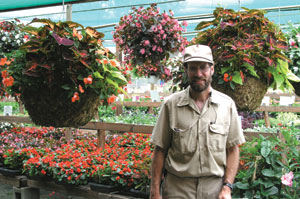4/15/2010
Picking Up the Pieces
Barbara Mulhern

It wasn’t anything Todd Jaeger had planned.
Todd, who with his wife Jackie started Jaeger Family Greenhouses in 1985, unexpectedly found his entire operation flooded out eight years later. But since it reopened, he has had unlimited fuel to heat his greenhouses, the ability to shorten his growing time by four to six weeks, and has saved an estimated $12,000 to $15,000 per year.
“There was a period of time when we didn’t know what we would do,” says Todd, a retail grower who has seven children and grows about 90% of the product he sells. In response to the flooding, customer Bill Powell, co-owner of Fred Weber, Inc., offered Todd and his family a place to live and an opportunity to use some greenhouses located near a landfill and a quarry in Maryland Heights, Missouri.
“They had been using methane gas as a test (to heat the greenhouses),” Todd says. “After a year, we built more greenhouses. The use of methane drastically changed the timing of our growing. We used to start at the end of December growing cool, but when we switched to methane we found we could start our geranium baskets the first week of February. The methane enables us to run the temperature however we like it at any time.”
As part of the cost of its license to use the methane, Jaeger Family Greenhouses has access to an unlimited amount of the fuel. Todd estimates that has saved his operation $12,000 to $15,000 per year.
Differentiation
Today, Todd and Jackie, whose children all work in the greenhouses seasonally or part-time, cater predominantly to a middle-class customer base on the west side of St. Louis. “Our customer base has grown by word of mouth,” Todd says.
One way Jaeger Family Greenhouses continues to meet its customers’ needs—and differentiate itself from nearby competitors—is by growing hard-to-find and unusual plants. A few examples, Todd says, are Dixie Wood Fern, Autumn Bride, Pink Elephant and Platt’s Black.
The use of methane enables Todd to grow the plants in different sections of a greenhouse at different temperatures. Also, instead of holding the temperature at 60F (16C) during the day as he was doing for some of his plants, then turning it down at night, “we can go the opposite way,” he says.
Jaeger Family Greenhouses’ sale of Proven Winners plants has “grown and grown as our customers continue looking for plants that are different,” Todd notes. He adds that he has several salespeople who would like to have one of each of everything that’s grown at the operation.
Lessons learned
Like other small greenhouse growing operations, Jaeger Family Greenhouses has been affected by the recent down economy. As a result, it has stepped up advertising by participating in local farmers’ markets in some of the St. Louis suburbs.
“If we have an opportunity to put our product out to the people, that speaks for itself,” Todd believes. “Also, when we do any advertising, we always include actual pictures of our place with our employees or our family. It has puzzled me why more people don’t do this.”
Putting an emphasis on large baskets such as pink, purple or blue giant petunias, has also helped. “These are our showiest products because they are so big. When we go to farmers’ markets, people say: ‘I’ve never seen such big plants,’” he says.
Another way Todd and Jackie have adjusted to the economy is by raising prices 1% to 2% annually instead of 3% to 5% as they did in the past. They have also depended more on family members for labor. Because their children are getting older and can work in the greenhouses, they have been able to get all of the work done with just five outside employees.
Finally, Jaeger Family Greenhouses used to grow all of its perennials in quarts, then modified that to gallons eight to 10 years ago. “But with the current economy, we are going back to growing some of them in quarts,” Todd says.
He has these suggestions for other small retail growers based on what he and Jackie have learned over the years:
- Don’t build a greenhouse range on a hill. Despite his previous flooding problems from being located near a river bottom, Todd says that having greenhouses on a hill isn’t without its own problems. For example, he says, moving plants from the greenhouses to an outdoor sales area is difficult. Jaeger Family Greenhouses moves virtually all of the plants it grows from its greenhouses to the outdoor sales area each spring.
- Make things easy for your customers. “We have an asphalt paved parking lot. Have everything paved,” he suggests. “We also have a big area where we produce our own signs, so we can word them exactly how we want. With this signage, we can tell our customers exactly what they need to know.”
In the future, Todd would like to have a second sales area in a wealthier part of the St. Louis metropolitan area. “But it’s hard to leave the methane gas,” he says.
GT
Barbara Mulhern is a freelance writer from Verona, Wisconsin.